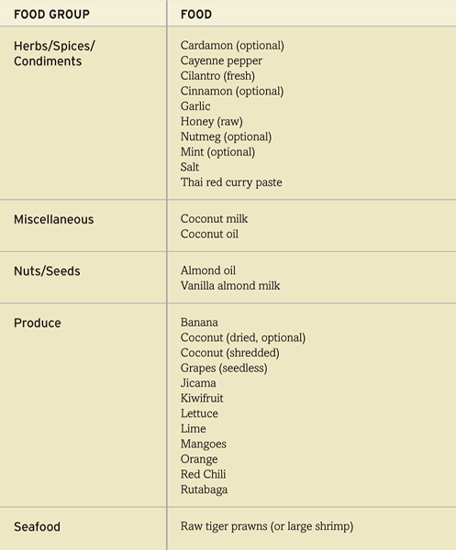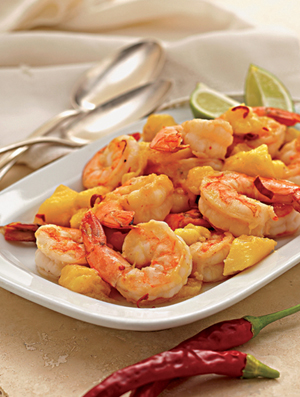

Thai-Spiced Mango and Prawns
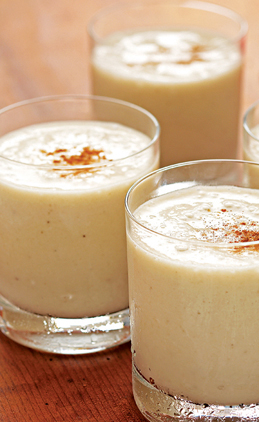
Tropical Frosties

Roasted Rutabaga Chips
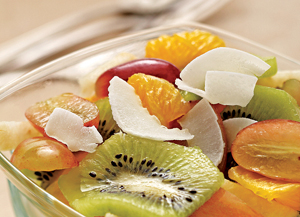
Crunchy Coconut Fruit Salad
124 Thai-Spiced Mango and Prawns
126 Crunchy Coconut Fruit Salad
I’VE GOT a great story about coconut. It will probably tell you more about why you should take the nutrition info you read in magazines with a tablespoon or two of salt; but be patient, and I’ll also get to the good parts about coconut.
First the story.
Not too long ago I was asked to write a story called “Healthy Foods That People Aren’t Eating” for a very famous magazine. An easy assignment: I listed all the foods that people fear (such as egg yolks) and some of the many healthy foods that most people are deeply misinformed about.
And at the top of my list was coconut and coconut oil.
Fast-forward a couple of weeks. The story came back from the editor for a final fact-check and sign off. But the entire section on coconut was missing.
I called up the editorial assistant. “What gives?” I asked. The editorial assistant explained that the editor had simply taken out the section on coconut. “She doesn’t think it’s healthy,” she said. “It has saturated fat.” My jaw dropped to the floor, and I took my name off the story.
THE UNSUNG COCONUT
The prejudices against certain foods run very deep indeed. (Don’t get me started on my friends who still order egg white omelets because they’re afraid of the cholesterol in egg yolks.) And the reputation of coconut—so delicious here in the Crunchy Coconut Fruit Salad—has certainly not been helped by the American fat phobia. For far too long, this amazing, healthy, vital food has been relegated to the category of “foods that are bad for you” and forgotten about.
The fat in coconut is largely saturated, it’s true, but it’s a type of saturated fat called medium-chain triglycerides, MCTs for short. These wonderful fats have some very specific qualities that make them special. For one thing, they’re easy to metabolize. The body actually likes to use them for energy rather than for storage, so they’re much less likely to wind up on your hips. Bodybuilders have long loved MCTs because they give them energy while dieting and are highly unlikely to put on fat.
Another quality of MCTs is that they contain a special fatty acid called lauric acid, which is a great boon to your immune system. It’s antiviral and antimicrobial, has some positive effects on immunity, and according to the Physicians’ Desk Reference, may actually be helpful against some cancers.
Fifty percent of the fat in coconut is made up of lauric acid. In the body, lauric acid forms into a compound called monolaurin, which is basically a bug killer. According to naturopath Bruce Fife, N.D., lauric acid has been shown to be effective against Streptococcus (throat infections, pneumonia, sinusitis), Staphylococcus (food poisoning, urinary tract infections), H. pylori (stomach ulcers), and other bacterial pathogens.
Another 6 or 7 percent of the fatty acids in coconut are an MCT called capric acid, which forms into monocaprin, a compound that has been shown to have antiviral effects and antibacterial effects against sexually transmitted bacteria. The MCTs in coconut also kill Candida albicans (yeast) and other fungi in the intestinal tract, further supporting healthy gut ecology.
Back in the ’60s and ’70s, research was done on the native diet of people from the Pacific Islands and Asia who were surprisingly free from cardiovascular disease and cancer. One study examined the diet of people living in the small, idyllic islands of Tokelau and Pukapuka. These folks ate a high-fat diet—deriving 35 to 60 percent of their calories from fat—and most of it was from coconut. Yet the islanders were blissfully free of arthrosclerosis, heart disease, and colon cancer; digestive problems were rare; and the islanders were lean and healthy. The question of the healthfulness of coconut and coconut oil should have been settled back then, but prejudices and misinformation die hard. Not to worry. There’s plenty of coconut in this Thai-flavored meal to feed your immune system and support your heart.
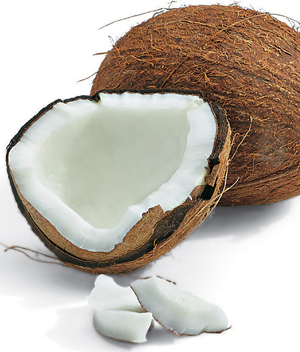
When buying coconut oil, go for the best: virgin or extra virgin coconut oil. It’s never hydrogenated or partially hydrogenated—meaning it doesn’t contain any dangerous trans fats—and it’s processed without high heat or chemicals, so you get all the nutrition that’s available.
My personal favorite is Barlean’s Extra-Virgin 100% Organic Coconut Oil, which comes in a tub and is widely available in stores. You can also buy it under “Healthy Foods” on my website, www.jonnybowden.com.
Try using extra virgin coconut oil as a cooking oil for eggs. Use it in place of butter or mix it with a little organic butter. Simply heat it up and fry or scramble the eggs. I start with a bunch of vegetables, let them soften for a couple of minutes, add the eggs, and mix it up. Season it with curry and lemon pepper. It’s amazing. My favorite breakfast dish is to start off with some sliced apples, add the vegetables when the apple slices are transparent, and carry on with the eggs.
PROTEIN-PACKED PRAWNS
The main dish, Thai-Spiced Mango and Prawns, features prawns or shrimp cooked in—what else—coconut oil! Shrimp are a great source of protein, containing a whopping 17 g in a small 3-ounce serving. They’re also really low in calories and loaded with a powerful antioxidant called astaxanthin, which is a member of the carotenoid family that includes better-known beta-carotene and lutein. But astaxanthin has even more antioxidant power than either of them. Some studies suggest that it can be 100 times more effective as an antioxidant than vitamin E. (Salmon, by the way, get their red color from eating the pigmented astaxanthin found in crustaceans like shrimp.)
Oh, and if you’re wondering what the difference between shrimp and prawns are, the answer is not a whole lot. Mainly size. Prawns are just really big shrimp, though there are some differences of opinion about the distinctions. One particularly desirable type is the black tiger prawn, which can grow to more than a foot in length.
While we’re on a myth-busting roll from our discussion of coconut, let’s deal with the cholesterol in shrimp, which is one reason many people avoid eating them. Put that little piece of misinformation to rest. The cholesterol in food, such as eggs and shrimp, has virtually no effect on the cholesterol in your blood. For more than 99 percent of the population, it’s highly unlikely that the cholesterol in shrimp will have any meaningful effect whatsoever on your blood cholesterol. In fact, in one study published in 1996, subjects ate 300 g of shrimp a day (approximately 12 ounces!), and although their overall cholesterol went up a bit, most of it was the good cholesterol, meaning their overall cholesterol profiles actually improved! And even more important, their triglycerides dropped. So eat and enjoy.
MORE GREAT SUPERFOODS
Here are a couple of other highlights in this meal. One of them is jicama, which I’m willing to bet many people have never heard of. Neither had I, till my friend Ann Louise Gittleman, Ph.D., C.N.S., turned me on to it. It’s a root vegetable that is low calorie, high fiber, crunchy, and cooling. The high fiber of jicama alone makes it worth the price of admission, but it also comes with a little bonus serving of magnesium and potassium. You’ll love it in the Crunchy Coconut Fruit Salad.
Another highlight of the Crunchy Coconut Fruit Salad is grapes, about which I can’t say enough good things. The skins of dark grapes are a great source of resveratrol, which is one of the most promising antiaging compounds around. Resveratrol has extended the life span of every life form tested so far—yeast cells, fruit flies, worms, and mice—and it appears to extend life in our primate relatives as well. The seeds and skins of grapes also contain flavonoids, which help protect against the effects of internal and environmental stresses. And the latest research on grape juice, which contains the same beneficial compounds as grapes themselves, shows that it can make blood less likely to clot and increase the elasticity of blood vessels.
One more highlight of this meal is my favorite French fry substitute: Roasted Rutabaga Chips. This is the kind of creative thinking a chef like Jeannette, who is also a mother, comes up with when she has to deal with kids wanting to eat at McDonald’s every day. Rutabagas, which are basically big fat turnips, blow the socks off white potatoes as a basis for fries. They’re low in carbs, high in fiber (3.5 g per cup), and loaded with potassium. And they cost you all of about 50 calories a cup. Plus, baked rutabagas taste pretty darn good. Maybe even good enough to make your kids forget the Golden Arches.
Well, almost.
Meal Prep Tips
• Prepare the marinade/dressing for the Thai-Spiced Mango and Prawns first and marinate the prawns for at least 30 minutes.
• Prepare and cook the Roasted Rutabaga Chips while the prawns are marinating.
• Prepare and dress the Crunchy Coconut Fruit Salad just before cooking the prawns.
• You can blend the Tropical Frosties right before the meal and serve them along with dinner to cool the fire of the dishes, or you can serve them right afterward in traditional dessert style.
THE ANTIDOTE TO THE GOLDEN ARCHES
Speaking of kids forgetting about the Golden Arches (hey, we can dream, can’t we?), wait until they taste the Tropical Frosties for dessert. Combining the flavor of coconut (the coconut ice cubes Jeannette came up with are pure genius!) together with banana in a nondairy base sweetened with enzyme-rich raw honey is pure joy. Your kids may never ask for a “slurpy” again after they taste this one!
Enjoy!
At first it seems simple: If shellfish and fish contain mercury, don’t eat them. But the truth about shellfish and fish and mercury is a bit more complicated than it seems.
Health advisories have had to walk a fine line between scaring people away from shellfish, which is probably the healthiest source of protein and omega-3 fatty acids on the planet, and trying to control exposure to mercury. One major study found that if pregnant women were to simply replace fish high in mercury with fish low in mercury, cognitive benefits per newborn baby (of about a tenth of an IQ point) could be achieved with no loss of nutrition. But if people were scared off fish and stopped eating it, the loss of omega-3 fats during pregnancy would cut nutritional benefit by a whopping 80 percent. And if other adults—men and nonpregnant women—were to be scared off fish and decrease it even by one-sixth, risk from coronary heart disease and stroke would increase.
The fact is, many fish are also high in selenium, a fantastic mineral that binds to mercury and helps your body excrete it. The high levels of selenium in fish are believed to be responsible for the fact that people on the Seychelle Islands eat about twelve servings of fish a week with no observable problems.
I think the compromise solution offered by the Environmental Protection Agency (EPA) for women of childbearing age, pregnant women, and nursing mothers makes sense for everyone who wants to take a conservative approach. Here’s what they recommend:
• Eat up to two fish meals a week of most fish, including salmon, catfish, and canned light tuna.
• Eat no swordfish, king mackerel, shark, or tilefish, which are especially high in mercury.
• Eat no more than 6 ounces (170 g) a week of albacore (white) tuna.
Personally, I think it’s safe to eat fish (and shellfish) more frequently, especially if you seek out good, fresh, pure sources from reliable providers, but the EPA guidelines are a good compromise. Remember, too, that those guidelines are for those women who might become pregnant or who are pregnant or nursing. Projecting the possible risks of eating fish a few times a week for nonpregnant people is a fool’s game and gets you into far more murky waters.
I’d make a major bet that any typical dinner at a fast food restaurant poses far more danger to your overall health than any fish dish I can imagine eating.
And I don’t personally know any nutritionist who’d take that bet.
Antioxidants from the sea
Prep Time: 15 minutes, marinate 30 minutes
Cook Time: 1 minute
Ingredients
5 tablespoons (75 ml) coconut milk
1 to 1½ tablespoons (15 to 22 g) Thai red curry paste
2 tablespoons (8 g) fresh cilantro, finely chopped
1 small red chili, seeds removed and finely sliced
2 cloves garlic, finely minced
Juice of 1 lime
2 ripe mangoes
2 pounds (900 g) raw tiger prawns or large shrimp, deveined and shells removed, but tails intact
2 teaspoons (10 ml) coconut oil
4 large lettuce leaves, optional
1 lime, cut into 4 wedges, optional
In a medium bowl, combine the coconut milk, curry paste, cilantro, chili, garlic, and lime juice and whisk together to blend. Set half of the mixture aside to use as a dressing on the cooked shrimp.
Peel the mangoes, then cut the side “cheeks” of flesh away and slice them into wedges. Toss the prawns or shrimp and mango wedges in the marinade and place in the refrigerator for at least 30 minutes.
Chop the remaining mango from around the stones and add it to the reserved dressing mixture.
Heat the oil in a griddle pan or wok over medium-high heat until hot. Cook the prawns and mango for approximately 30 seconds on each side, until the prawns turn pink and the mango is softened.
Arrange the prawns and mango on a serving platter or over the lettuce, if using, and drizzle with the reserved dressing. Serve with the lime, if using.
Yield: 4 servings
• It takes a little while to peel shrimp, but once they are ready, the cooking time is brief. You can buy them precleaned and frozen, which is great for a quick recipe or to have on hand as an easy protein to add to a salad.
• The sweet and pungent flavors of this dish are very characteristic of Thai cooking. The cool of the fruit softens the heat of the curry paste.
• Sweet tropical fruits, such as mangoes, papayas, and bananas, are very high in sugar, so they are best eaten sparingly in season: in the high heat of summer or when you travel to hot climates.
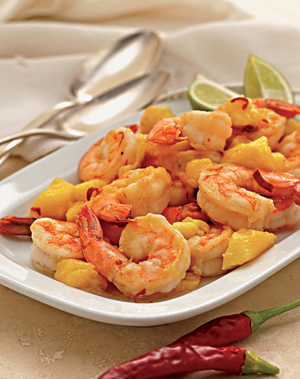
Feed your immune system with antiviral agents
Prep Time: 10 minutes
Cook Time: None
Ingredients
1 medium jicama, peeled and julienne cut (about 1½ cups or 195 g)
½ cup (75 g) seedless grapes, halved
2 kiwifruit, peeled and cut into thin rounds
1 large orange, peeled, one half segmented and segments cut into thirds
¼ cup (18 g) shredded unsweetened coconut
Place the jicama in a medium bowl. Place the grapes, kiwi, and orange segments on top.
In a small bowl, juice the remaining orange half (about ¼ cup or 60 ml juice) and mix with the coconut. Pour over the salad, toss well, and serve.
Yield: 4 servings
• The secret sweet crunch of jicama: If you haven’t yet tried this humble vegetable, now is the time to give it a whirl. It is fat-free and relatively low carb (11 g per cup with 6 g of fiber), yet it has a satisfying juicy and sweet crunch, kind of a cross between an apple and a white potato. Look for jicama with the root veggies in your supermarket. It’s a tuber with a thick, tan skin. Choose a firm one with no bruising.
• Peel jicama right before using because, like an apple, it will brown slightly with air exposure.
• Jicama is great raw or lightly cooked. It stays crunchy in stir-fries.
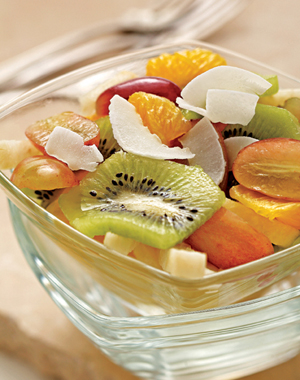
Fabulously crunchy fiber
Prep Time: 10 minutes
Cook Time: 30 minutes
Ingredients
1 pound (455 g) rutabaga (1 large)
2 teaspoons (10 ml) almond oil Cayenne pepper
Salt
Preheat the oven to 400°F (200°C, gas mark 6).
Peel the rutabaga and slice it into thin rounds. Cut each round into quarters.
In a large bowl, toss the rutabaga with the oil and cayenne pepper and salt, to taste.
Place the rutabaga in a single layer on a large baking sheet. Bake, turning occasionally, until the rutabaga is caramelized and soft, being careful not to burn, for 25 to 30 minutes.
Yield: 4 servings
• You can use this basic recipe for many other root vegetables. It’s especially good with sweet potato, parsnip, and carrots.
• Rutabagas look similar to turnips. However, turnips are smaller, thinner, and usually have white skin and tender greens. Baby spring turnips are so mild you can eat them raw as a salad radish. Rutabagas are larger than turnips and have yellow, slightly drier flesh and tougher skin. They are thought to be a cross between turnips and cabbages.
• If you do a lot of vegetable slicing, it may be worth your while to purchase a mandoline—a hand-operated utensil that can be fitted with various blades for cutting uniform slices or julienne strips. It’s very helpful for slicing firmer roots and vegetables, such as rutabagas and carrots.
• While it may be unusual, we use almond oil for three reasons: First, it’s a way to get the mandatory nuts in; second, it’s good at high heat; and third, it has a mild flavor that complements many foods very well.
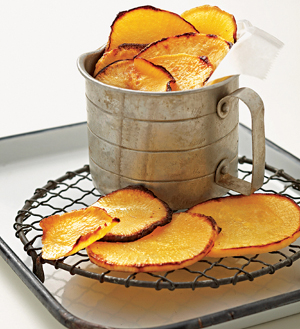
Healthy, exotic, and enzyme-rich
Prep Time: 3 minutes
Cook Time: None
Ingredients
16 ounces (2 cups, 475 ml) chilled unsweetened vanilla almond milk (see “Notes from the Kitchen”)
1½ frozen bananas (see “Notes from the Kitchen”)
3 light coconut milk “ice cubes” (see “Notes from the Kitchen”)
1 teaspoon raw honey, optional
Spring water ice cubes, optional
Sprinkle nutmeg, cardamom, cinnamon, dried coconut, or mint, optional
Place the vanilla almond milk, bananas, coconut milk “ice cubes,” and honey, if using, into a blender and mix until smooth and creamy. Add the spring water ice cubes to taste for more thickness, if using.
If you have the bananas and coconut milk but they aren’t prefrozen, add 3 to 5 spring water ice cubes to the ingredients and blend as directed.
Divide into 4 chilled short glasses, sprinkle with the desired seasoning, and serve immediately.
Yield: 4 servings
• Unsweetened almond milks are readily available in health food stores, but it is actually quite easy and much cheaper to make your own fresh: Combine 1 cup (150 g) raw almonds with 4 cups (946 ml) water in bowl. Cover and refrigerate overnight. In the morning, blend the mixture well and strain the liquid through cheesecloth, pressing it firmly to release all the milk. Store the almond milk covered in the refrigerator for a couple of days. Shake before using, because it tends to separate.
• You can substitute any milk for the almond milk. Raw cow or unsweetened rice work equally well.
• When bananas are getting overripe, freeze them for future use in frosties or smoothies. To freeze bananas, peel them, break them in half, wrap them individually in waxed paper, place them in a freezer resealable plastic bag, and freeze for at least 4 hours and up to a month.
• To make coconut milk “ice cubes,” pour a can of light coconut milk into an ice-cube tray and freeze it overnight. Transfer the frozen cubes to a resealable plastic freezer bag and store them in the freezer until needed.
• For a delicious chocolate version, add 1 heaping tablespoon (9 g) raw cacao (or 2 teaspoons/6 g high-quality cocoa powder) and 1 tablespoon (20 g) agave nectar. Sprinkle with cinnamon.
• Here’s another delicious and beautifully simple alternative: Peel and seed a medium-sized ripe cantaloupe or 6 cups (930 g) watermelon, chill it well (or freeze it and thin slightly with almond milk if necessary), and blend it into a creamy drink in the blender. It’s light, sweet, and very refreshing!

Most vegetable contamination, including the recent spinach scare, comes, surprisingly, not from pesticides but from water.
“Runoffs from streams and rivers overflow the banks and get into the fields where the crops are growing,” says Sanford Miller, Ph.D. “Sometimes the [food] producers even use water from these sources, and if they have been contaminated—say by animals—the crops become contaminated, too.”
In the case of the spinach scare, the contamination was traced to nearby streams. While buying organic protects you from pesticides, it doesn’t protect you from water contamination. “But organic farmers do tend to be more conscientious,” he added.
Though there’s not much the consumer can do when there’s been wholesale contamination of a crop by water, the rule of thumb remains: refrigerate, refrigerate, refrigerate. “Refrigeration always slows the growth of bugs, even when something has been contaminated,” Miller said.
As for fish, the best test for contamination is the smell test. “Fish should never smell fishy,” Miller said. “It should smell fresh. If you even think something smells funny, throw it out. Smell is the best indicator we have that something’s wrong.”
Here are some highlights from the U.S. Department of Agriculture’s recommendations for food safety:
• Always refrigerate food within two hours of buying (one hour when it’s hot outside)
• Refrigerators should be at 40°F (4°C) and freezers at 0°F (-18°C)
• Cook or freeze meat, poultry, or fish within two days of purchase
• Wrap animal products securely and don’t let meat juices get on other foods
• Wash hands with warm water and soap before and after food handling
• Cook beef, veal, lamb, roasts, and chops to 145°F (63°C), pork and ground meat to 160°F (71°C), and poultry to 165°F (74°C)
Get the complete set of food safety guidelines at www.fsis.usda.gov/Fact_Sheets/Basics_for_Handling_Food_Safely/index.asp
